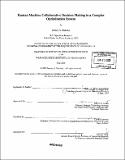Human machine collaborative decision making in a complex optimization system
Author(s)
Malasky, Jeremy S
DownloadFull printable version (8.693Mb)
Other Contributors
Massachusetts Institute of Technology. Operations Research Center.
Advisor
Milton B. Adams and Cynthia Barnhart.
Terms of use
Metadata
Show full item recordAbstract
Numerous complex real-world applications are either theoretically intractable or unable to be solved in a practical amount of time. Researchers and practitioners are forced to implement heuristics in solving such problems that can lead to highly sub-optimal solutions. Our research focuses on inserting a human "in-the-loop" of the decision-making or problem solving process in order to generate solutions in a timely manner that improve upon those that are generated either scolely by a human or solely by a computer. We refer to this as Human-Machine Collaborative Decision-Making (HMCDM). The typical design process for developing human-machine approaches either starts with a human approach and augments it with decision-support or starts with an automated approach and augments it with operator input. We provide an alternative design process by presenting an 1HMCDM methodology that addresses collaboration from the outset of the design of the decision- making approach. We apply this design process to a complex military resource allocation and planning problem which selects, sequences, and schedules teams of unmanned aerial vehicles (UAVs) to perform sensing (Intelligence, Surveillance, and Reconnaissance - ISR) and strike activities against enemy targets. Specifically, we examined varying degrees of human-machine collaboration in the creation of variables in the solution of this problem. We also introduce an IIHMCDM method that combines traditional goal decomposition with a model formulation into an Iterative Composite Variable Approach for solving large-scale optimization problems. (cont.) Finally, we show through experimentation the potential for improvement in the quality and speed of solutions that can be achieved through the use of an HMCDM approach.
Description
Thesis (S.M.)--Massachusetts Institute of Technology, Sloan School of Management, Operations Research Center, 2005. Includes bibliographical references (p. 149-151).
Date issued
2005Department
Massachusetts Institute of Technology. Operations Research Center; Sloan School of ManagementPublisher
Massachusetts Institute of Technology
Keywords
Operations Research Center.